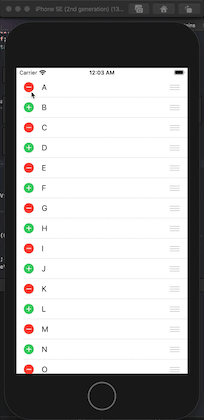1
2
3
4
5
6
7
8
9
10
11
12
13
14
15
16
17
18
19
20
21
22
23
24
25
26
27
28
29
30
31
32
33
34
35
36
37
38
39
40
41
42
43
44
45
46
47
48
49
50
51
52
53
54
55
56
57
58
59
60
61
62
63
64
65
66
67
68
69
70
71
72
73
74
75
76
77
78
79
80
81
82
83
84
85
86
87
88
89
90
91
92
93
94
95
96
97
98
99
100
101
102
| #import "ViewController.h"
@interface ViewController ()<UITableViewDataSource,UITableViewDelegate>
//数据列表
@property (nonatomic,strong) NSMutableArray *dataList;
@property (nonatomic,strong) UITableView *tableView;
@end
@implementation ViewController
- (UITableView *)tableView
{
if (_tableView==nil) {
_tableView=[[UITableView alloc]initWithFrame:self.view.bounds style:UITableViewStylePlain];
_tableView.dataSource=self;
_tableView.delegate=self;
[self.view addSubview:_tableView];
}
return _tableView;
}
- (NSMutableArray *)dataList
{
if (_dataList==nil) {
_dataList=[NSMutableArray arrayWithObjects:@"A", @"B",@"C",@"D", @"E",@"F",@"G", @"H",@"I",@"J", @"K",@"L",@"M", @"N",@"O",@"P", @"Q",nil];
}
return _dataList;
}
- (void)viewDidLoad {
[super viewDidLoad];
[self tableView];
self.tableView.editing=YES;
}
#pragma 数据项
- (NSInteger)tableView:(UITableView *)tableView numberOfRowsInSection:(NSInteger)section
{
return self.dataList.count;
}
//单元格内容
- (UITableViewCell *)tableView:(UITableView *)tableView cellForRowAtIndexPath:(NSIndexPath *)indexPath
{
static NSString *ID=@"Cell";
UITableViewCell *cell=[tableView dequeueReusableCellWithIdentifier:ID];
if (cell==nil) {
cell=[[UITableViewCell alloc]initWithStyle:UITableViewCellStyleDefault reuseIdentifier:ID];
}
//设置内容
cell.textLabel.text=self.dataList[indexPath.row];
return cell;
}
#pragma 代理
- (void)tableView:(UITableView *)tableView commitEditingStyle:(UITableViewCellEditingStyle)editingStyle forRowAtIndexPath:(NSIndexPath *)indexPath
{
if (editingStyle==UITableViewCellEditingStyleDelete) {
NSLog(@"要删除..");
[self.dataList removeObjectAtIndex:indexPath.row];
NSLog(@"%@",self.dataList);
//刷新
//[self.tableView reloadData];
[self.tableView deleteRowsAtIndexPaths:@[indexPath] withRowAnimation:UITableViewRowAnimationMiddle];
}else if(editingStyle==UITableViewCellEditingStyleInsert)
{
NSLog(@"要添加数据");
[self.dataList insertObject:@"Z" atIndex:indexPath.row+1];
//刷新数据
NSIndexPath *path=[NSIndexPath indexPathForRow:indexPath.row+1 inSection:indexPath.section];
[self.tableView insertRowsAtIndexPaths:@[path] withRowAnimation:UITableViewRowAnimationMiddle];
}
}
// 只要实现此方法,就可以显示拖动控件
- (void)tableView:(UITableView *)tableView moveRowAtIndexPath:(NSIndexPath *)sourceIndexPath toIndexPath:(NSIndexPath *)destinationIndexPath
{
// 界面数据UITableView已经完成了
// 调整数据即可
// [self.dataList exchangeObjectAtIndex:sourceIndexPath.row withObjectAtIndex:destinationIndexPath.row];
// 1. 将源从数组中取出
id source = self.dataList[sourceIndexPath.row];
// 2. 将源从数组中删除
[self.dataList removeObjectAtIndex:sourceIndexPath.row];
NSLog(@"%@", self.dataList);
// 3. 将源插入到数组中的目标位置
[self.dataList insertObject:source atIndex:destinationIndexPath.row];
NSLog(@"%@", self.dataList);
}
#pragma mark - 代理方法
// 返回编辑样式,如果没有实现此方法,默认都是删除
- (UITableViewCellEditingStyle)tableView:(UITableView *)tableView editingStyleForRowAtIndexPath:(NSIndexPath *)indexPath
{
if (indexPath.row % 2) {
return UITableViewCellEditingStyleInsert;
} else {
return UITableViewCellEditingStyleDelete;
}
//return UITableViewCellEditingStyleInsert;
}
@end
|

